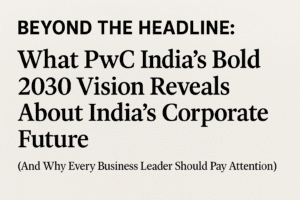Beyond the Headline: What PwC India’s Bold 2030 Vision Reveals About India’s Corporate Future
PwC India’s bold plan to triple revenue by 2030 isn’t just corporate ambition—it’s a strategic mirror to India’s own growth trajectory. By investing heavily in AI, tech-driven delivery, and 20,000 new jobs, the firm aims to align with national priorities like tier 2/3 city development and self-reliant local economies. Its expansion into emerging sectors and decentralization beyond metros signals a fundamental shift: future-ready businesses must blend deep sector expertise with scalable technology.
Crucially, PwC ties growth to human capital—prioritizing upskilling, women leaders, and inclusive culture—while acknowledging that trust and adaptability will define success in India’s evolving market. This blueprint reveals how consultancies must reinvent themselves to thrive in “Kal Ka Bharat.”

Beyond the Headline: What PwC India’s Bold 2030 Vision Reveals About India’s Corporate Future
(And Why Every Business Leader Should Pay Attention)
When a consulting giant like PwC India pledges to triple revenue by 2030, it’s not just corporate ambition—it’s a strategic weathervane for India’s entire economic landscape. Their newly unveiled “Vision 2030” goes beyond financial targets, mirroring India’s own growth narrative with striking clarity. Here’s what it really signals:
- The “Tier 2-3 Revolution” Is Now Corporate Strategy
PwC’s plan to expand into smaller cities (creating 20,000+ jobs) isn’t CSR—it’s recognition that India’s next growth wave will emerge beyond metros. By decentralizing talent, they’re tapping into underleveraged skill pools while aligning with government initiatives for regional economic self-sufficiency. Takeaway: Businesses ignoring Bharat’s talent and markets risk irrelevance.
- Consulting’s Core Business Model Is Being Rewritten
A 5% annual revenue commitment to tech/AI and “GenAI-driven delivery” signals a seismic shift:
- From: Advisory reports and human-led processes
- To: Scalable tech products, AI-augmented solutions, and outcome-based platforms
This isn’t digitization—it’s a full-scale reinvention of professional services.
- “Kal Ka Bharat” Isn’t a Slogan—It’s a Client Mandate
PwC’s six “Go Long” sectors (Financial Services, Healthcare, Auto, etc.) and emerging “Horizon Sectors” reflect where India is investing. Their growth hinges on solving clients’ reinvention challenges in:
- Sustainable industrialization
- Regulatory complexity
- Cybersecurity threats
- Human-centric tech adoption
Translation: They’re betting on India’s macro-economic priorities.
- The Talent War Just Got More Nuanced
With 1% of revenue dedicated to upskilling and “prioritizing women in leadership,” PwC acknowledges that:
- Future readiness > Past credentials
- Retention requires “inclusive growth journeys” (not just paychecks)
- Tier 2/3 talent pipelines are strategic, not charitable
- Trust Is the New Competitive Moats
Repeated emphasis on becoming a “trusted partner” underscores a market reality: In an age of AI-driven disruption and ethical risks, clients pay premiums for integrity and accountability—not just efficiency.
The Unspoken Challenge
Scaling from 30,000 to 50,000 professionals while tripling revenue implies radical productivity leaps. Can PwC’s human-centric culture withstand AI-driven delivery pressures? Their “Value in Motion” framework will face real-world stress tests.
Why This Matters to You (Even If You’re Not a PwC Client)
PwC’s strategy crystallizes broader trends every Indian business must navigate:
- Tech+Human Synergy: AI won’t replace experts—but experts using AI will replace those who don’t.
- Decentralization = Resilience: Distributed talent models mitigate urban saturation risks.
- Purpose Is Profitable: Aligning with national goals (sustainability, inclusion) attracts talent and clients.
As Sanjeev Krishan noted, this is about “growing with India, for India.” PwC’s blueprint reveals less about their ambitions—and more about the future every Indian enterprise will inhabit.
The question isn’t whether your business should respond. It’s how fast you can adapt.
You must be logged in to post a comment.